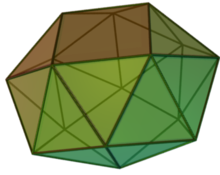Snub square antiprism
| Snub square antiprism | |
|---|---|
 |
|
| Type |
Johnson J84 - J85 - J86 |
| Faces | 8+16 triangles 2 squares |
| Edges | 40 |
| Vertices | 16 |
| Vertex configuration | 8(35) 8(34.4) |
| Symmetry group | D4d |
| Dual polyhedron | - |
| Properties | convex |
| Net | |
 |
|
In geometry, the snub square antiprism is one of the Johnson solids (J85).
A Johnson solid is one of 92 strictly convex polyhedra that have regular faces but are not uniform (that is, they are not Platonic solids, Archimedean solids, prisms or antiprisms). They were named by Norman Johnson, who first listed these polyhedra in 1966.
It is one of the elementary Johnson solids that do not arise from "cut and paste" manipulations of the Platonic and Archimedean solids, although it is a relative of the icosahedron that has fourfold symmetry instead of threefold.
The snub square antiprism is constructed as its name suggests, a square antiprism which is snubbed, and represented as ss{2,8}, with s{2,8} as a square antiprism.
Similarly constructed the ss{2,6} is a snub triangular antiprism (a lower symmetry octahedron), and result as a regular icosahedron. A snub pentagonal antiprism, ss{2,10}, or higher n-antiprisms can be similar constructed, but not as a convex polyhedron with equilateral triangles. The preceding Johnson solid, the snub disphenoid also fits constructionally as ss{2,4}, but you have to retain two degenerate digonal faces (drawn in red) in the digonal antiprism.
...
Wikipedia
